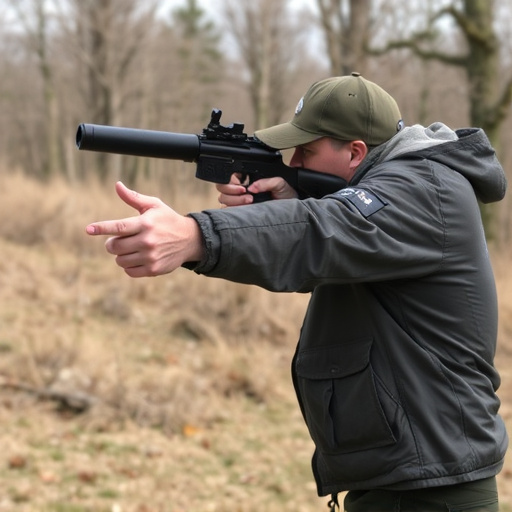OC spray's capsaicin concentration levels (0.5% – 10%) determine its effectiveness and risks. Higher concentrations enhance irritancy but may cause severe side effects. Law enforcement agencies balance these factors when selecting OC spray for strategic deployment, training, storage, and legal adherence to minimize harm while maintaining control.
“In the realm of law enforcement, effective crowd control and self-defense tools are paramount. One such tool that has gained prominence is the pepper spray weapon, specifically designed to incapacitate without causing permanent harm. This article delves into the intricacies of OC (Oleoresin Capsaicin) spray, focusing on its capsaicin concentration levels. We explore how law enforcement agencies utilize these concentrations for optimal effectivity while navigating safety measures and legal considerations surrounding their deployment.”
- OC Spray: Understanding Capsaicin Concentration
- Law Enforcement: Effective Pepper Spray Deployment
- Concentrations Explained: Mild to Severe Irritation
- Safety Measures: Handling and Storage Protocols
- Legal Considerations for Pepper Spray Use
OC Spray: Understanding Capsaicin Concentration
OC spray, also known as pepper spray, is a powerful tool used by law enforcement and security personnel for crowd control and self-defense. Understanding the capsaicin concentration levels in OC spray is crucial to grasp its effectiveness and potential risks. Capsaicin, the active ingredient in OC spray, is measured in percentage or parts per million (ppm).
Different types of OC spray have varying capsaicin concentrations, typically ranging from 0.5% to 2%. A higher concentration means more potent irritant properties, but it also increases the likelihood of side effects like temporary blindness, difficulty breathing, and severe pain. Law enforcement agencies must consider these factors when selecting the appropriate OC spray for their needs, balancing effectiveness with safety considerations.
Law Enforcement: Effective Pepper Spray Deployment
Law enforcement agencies worldwide have long recognized the effectiveness of pepper spray as a less-lethal force option. When deployed correctly, pepper spray can incapacitate an aggressor, providing officers with crucial time to gain control of a volatile situation. The key to effective pepper spray deployment lies in understanding and utilizing OC (Oleoresin Capsaicin) spray capsaicin concentration levels.
OC spray is measured in percent capsaicin, the active ingredient responsible for the burning sensation associated with chili peppers. Standard concentrations range from 1.5% to 2.0%, offering a powerful yet controlled level of incapacitation. Training officers on proper application techniques, including distance, angle, and duration of spray, ensures that the force is proportional to the threat, minimizing potential harm to bystanders and individuals with medical conditions. Effective deployment requires a strategic approach, taking into account environmental factors like wind and crowd control considerations to maximize the spray’s impact while maintaining safety.
Concentrations Explained: Mild to Severe Irritation
Pepper spray, or OC spray as it’s often referred to, is a non-lethal force tool used by law enforcement and security personnel. Its effectiveness relies on capsaicin, the active ingredient that causes irritation. Concentrations of capsaicin in pepper spray are measured in parts per million (ppm). These levels determine the severity of irritation the spray can cause.
Mild irritant levels typically range from 0.2% to 1% ppm. Such concentrations may result in temporary tearing, burning sensations, and difficulty breathing upon exposure. More potent levels, generally between 2% to 5% ppm, can induce severe coughing, chest tightness, nausea, and even blindness for several minutes. Concentrations above 10% ppm are considered extreme and can cause lasting respiratory distress, especially in individuals with pre-existing conditions or those exposed for extended periods.
Safety Measures: Handling and Storage Protocols
Law enforcement grade pepper spray weapons are powerful tools designed for self-defense and crowd control, but they come with strict safety measures that must be followed to ensure effective deployment and minimize risks. Handling and storage protocols are critical aspects of these procedures.
Officers undergo specialized training to understand the OC (Oleoresin Capsaicin) spray’s capsaicin concentration levels, which typically range from 1.5% to 2.0%. Proper handling involves wearing protective gear, including gloves and eye protection, to avoid direct contact with skin or eyes. Storage requires secure, designated areas with controlled temperatures and humidity to maintain the integrity of the spray canisters. Regular inventory checks and adherence to expiration dates are also vital to guarantee the readiness of these safety measures when needed.
Legal Considerations for Pepper Spray Use
Law enforcement grade pepper spray weapons, often referred to as OC (Oleoresin Capsaicin) spray, are powerful tools designed for crowd control and self-defense. However, their use is subject to strict legal considerations. The primary concern revolves around the capsaicin concentration levels in these sprays, which can vary widely. Typically, commercial-grade OC spray contains between 2% and 10% capsaicin, a chemical compound responsible for the burning sensation associated with spicy foods and pepper spray’s irritant effects.
Legal frameworks govern how and when law enforcement agencies can deploy these weapons. Use of force policies dictate when pepper spray is appropriate, often as a less-lethal alternative to firearms. Courts have established guidelines ensuring that its use is proportional and necessary in the given circumstances. Additionally, there are regulations around minimum age restrictions for carrying and using pepper spray, as well as storage and disposal requirements to prevent misuse or accidental exposure.
Pepper spray, or OC spray, has become a critical tool for law enforcement, offering a non-lethal means of self-defense. Understanding the capsaicin concentration levels is essential in effective deployment. From mild to severe irritation, these concentrations determine the spray’s impact and its suitability for different scenarios. With proper handling and storage protocols, along with a grasp of legal considerations, law enforcement can leverage OC spray effectively while ensuring safety and adhering to legal boundaries.
